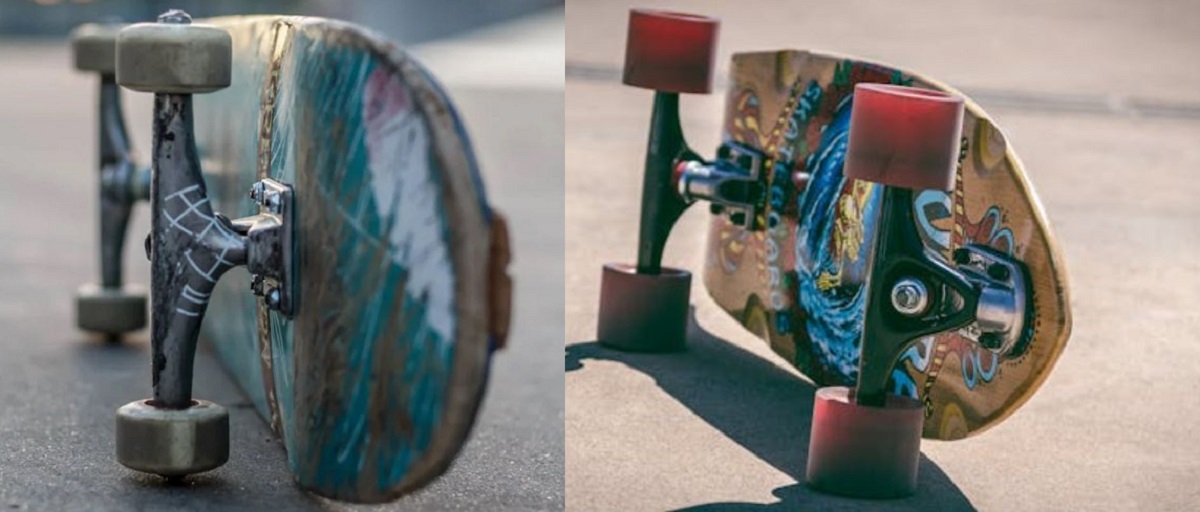When it comes to dialing in your ride, choosing skate wheels matter just as much as picking the right deck width. Wheels might look simple, but the hardness rating of a wheel’s polyurethane, its size, and the shape of the wheel all play a key role in determining how your skateboard handles.

Some wheels are better for vert and transition, while some are best for street. Then there are old-school cruiser wheels to consider. So, what’s best for your riding style and board setup? Let’s review.
Choosing a Skate Wheel Diameter

Pictured: Bones STF Retros 5V Sidecut (55mm)
All skate wheels are measured by the outer diameter, which is represented in millimeters. Virtually all standard skate wheels measure between 50 and 60mm, which larger wheels — 61mm to 75mm — found on old-school cruiser boards.
Wheel diameter directly affects your board’s acceleration, top speed, and ability to turn. Wheel diameter also affects your ride’s overall stability. Smaller wheels place the boarder closer to the ground, providing a lower center of gravity.
“What wheel size is best for me?”

Most skaters pick a wheel size based on their riding style.
48 to 51mm: Best for beginners, practice, and technical tricks.

Pictured: Spitfire Formula Four Firebolt (51mm)
These are some of the smallest wheels available. They provide the slowest top speed, a low center of gravity, and low acceleration. Wheels this small are ideal for beginner skaters who are practicing to push, and they’re great for keeping your composure while you learn to Ollie and practice new tricks.
NOTE: You should only ride on smooth pavement with wheels this small. They’re not suitable for street riding, as they’ll experience wheel-bite when hitting small imperfections on concrete and asphalt.
52 to 55mm: The most common skate wheel size.

Pictured: Ghetto Child James Windsor (52mm)
These are the most popular skate wheel diameters. Wheels in this range work best for a mix of street, transition, and vert riding. Skaters who ride street prefer 52mm, as they’re better for mastering technical tricks. Park and transition riders prefer 54mm, as they’re better for hitting higher speeds and grabbing air on park features.
56mm to 60mm: Best for dedicated vert and street carving.

Pictured: Powell Peralta ATF (59mm)
These larger wheels provide a bigger contact patch and extra high-speed stability, making them ideal for maximizing speed and control when dropping into bowls and riding large pipes and ramps. Larger diameter wheels also resist wheel-bite and can more easily handle rough terrain, making them well suited for cruising urban areas.
61mm – 70mm: For old-school boards, longboards, and rough roads.

Pictured: Slime Balls OG Slime Pink (66mm)
You’ll only find wheels this large on old-school and ultra-wide boards designed purely for cruising all terrain. These extra-large wheels also maximize speed and grip on downhill runs. They’ll also resist wheel-bite when rolling over larger debris on back roads.
70mm+: For longboards only.

Pictured: Powell Peralta Byron Essert (72mm)
Wheels this large are made specifically for longboarding. They’re simply too large to run on a standard deck and trucks, as their diameter will cause the wheels to rub into the bottom of the deck.
Check out our in-depth guide to longboard wheels here!
Choosing Skate Wheel Hardness (Durometer)

Wheel hardness can affect performance nearly as much as wheel diameter — so it’s important you’ve got the right wheel hardness for your riding style and terrain.
“How is skate wheel hardness measured?”
The Shore A and Shore B Durometer Scales measure wheel hardness, with numbers ranging from 0 to 101. Almost all skate wheels measure between 70a and 101a hardness. Wheels measured by the “B” scale are 20 points harder than wheels measured by the “A” scale. For example, a wheel measuring 80b hardness is the same as a wheel measuring 100a hardness.
But which hardness is best for your board? Let’s compare ratings.
78a to 87a: Best for longboards, street carving, skating rough surfaces.

Most longboard wheels measure in this hardness range, as do some cruiser-style skate wheels. Wheels this soft aren’t suitable for trick riding or riding vert or transition. They’re designed solely for handling rough surfaces, reducing wheel-bite and cushioning against debris and pavement cracks. 78a is best for dedicated cruising, while 80a to 85a are best for cruising and sliding.
88a to 95a: Good for cruising and street tricks.

Wheels in this hardness range provide good performance on rougher surfaces, but they’re hard enough to provide the speed and responsiveness required for performing street tricks. 92a wheels are the most popular hardness in this range.
96a to 101a: Best for transition, vert, and technical street.

Wheels in this hardness range best for dedicated vert, transition, and street skating with a focus on technical tricks. 99a wheels are the most popular hardness in this range.
Picking a Wheel Shape (Contact Patch)

Picking a skate wheel shape is pretty simple. You’ve got two choices: Wheels with rounded edges, and wheels with straight edges.
Virtually all standard skateboard wheels have rounded edges. This reduces the contact patch of the wheel, which reduces friction and promotes better acceleration and top speed.
Straight-edge wheels are almost exclusively used on cruiser-style boards and longboards. Their wider contact patch provides far more grip, while also allowing the wheel to more easily roll over debris.
Now you know everything you need to pick the perfect set of wheels! Check out our collection of skateboard wheels here. We’ve got loads of options from the most popular wheel brands., with different diameters and hardness ratings for all riding styles.


